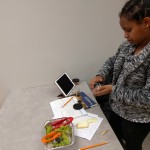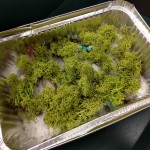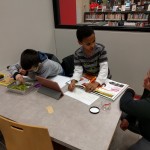Last month we shared a program for grades 3-5 at Skokie Public Library inspired by a visit to the Field Museum in Chicago about visualizing animals. This month we extended our inspiration and with the same grade range, focused on learning about animal specimens. Here’s what we did.
 We provided a brief slide presentation like the previous program to provide a foundation of knowledge before moving on to the hands on portion. The presentation defined “specimen” and provided photographs of various types of specimen, like life mounts, wet prep and pinned insects. We had a small group and they were all keen on sharing their opinions about each type of specimen and also questioned the point of preserving animals in this way.
We provided a brief slide presentation like the previous program to provide a foundation of knowledge before moving on to the hands on portion. The presentation defined “specimen” and provided photographs of various types of specimen, like life mounts, wet prep and pinned insects. We had a small group and they were all keen on sharing their opinions about each type of specimen and also questioned the point of preserving animals in this way.
This provided a natural transition into the importance of specimens in science and how there is strength in numbers. We then discussed holotypes, the first specimen of a new species, and used a holotype discovery example from the Field Museum. We ended the presentation by discussing the importance of labeling specimens accurately to support scientific research and study. We provided an example label of a brachiosaurus as well as handouts with the different parts of the label defined. Parts included: common name, two-part scientific name, where and what year the specimen was found, who found it, and a unique identifier.
Then participants were presented with their challenge: imagine you are a scientist out exploring anywhere in the world; you collect a specimen and then must identify and label it before heading back to your research lab.
 The kids eagerly got to work to excavate a specimen from a pretend discovery site created out of an aluminum pan with sand, rocks, and moss covering various plastic insects. They were provided a small plastic collection jar and a label handout. Participants used library books and the National Geographic for Kids website on iPads to research their specimen in order to gather enough information for the label. They could also use two handouts to write down or draw what they were seeing and label different parts to help with the identification process.
The kids eagerly got to work to excavate a specimen from a pretend discovery site created out of an aluminum pan with sand, rocks, and moss covering various plastic insects. They were provided a small plastic collection jar and a label handout. Participants used library books and the National Geographic for Kids website on iPads to research their specimen in order to gather enough information for the label. They could also use two handouts to write down or draw what they were seeing and label different parts to help with the identification process.
They really enjoyed asking questions to each other about their specimens and confirming they identified it correctly with the resources before writing down information on the label. They also consulted the natural habitat of each specimen before deciding where in the world they discovered it. The most questions participants had related to the unique identifier for the specimen. They weren’t entirely sure what that meant so we used the example of a library collection and call numbers to help provide context.
 Because the group was so small, each scientist got to identify and collect two insect specimens. They used additional sticker labels to transfer the information onto the jars. This program will be repeated in a drop-in format in our STEAM space, the BOOMbox. We hope it will inspire kids to begin their own specimen collections of rocks, plant matter, or even bugs.
Because the group was so small, each scientist got to identify and collect two insect specimens. They used additional sticker labels to transfer the information onto the jars. This program will be repeated in a drop-in format in our STEAM space, the BOOMbox. We hope it will inspire kids to begin their own specimen collections of rocks, plant matter, or even bugs.




Leave A Comment